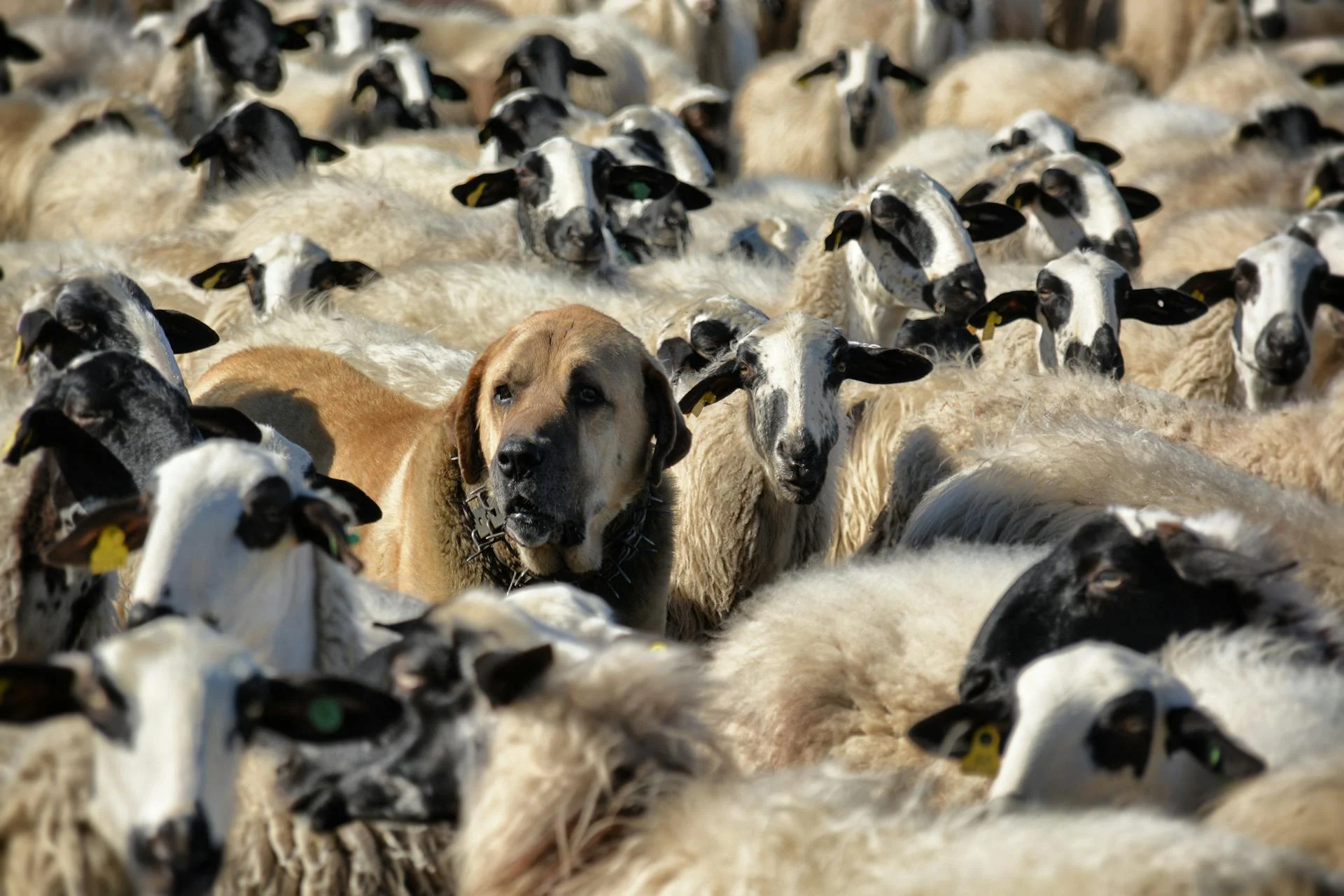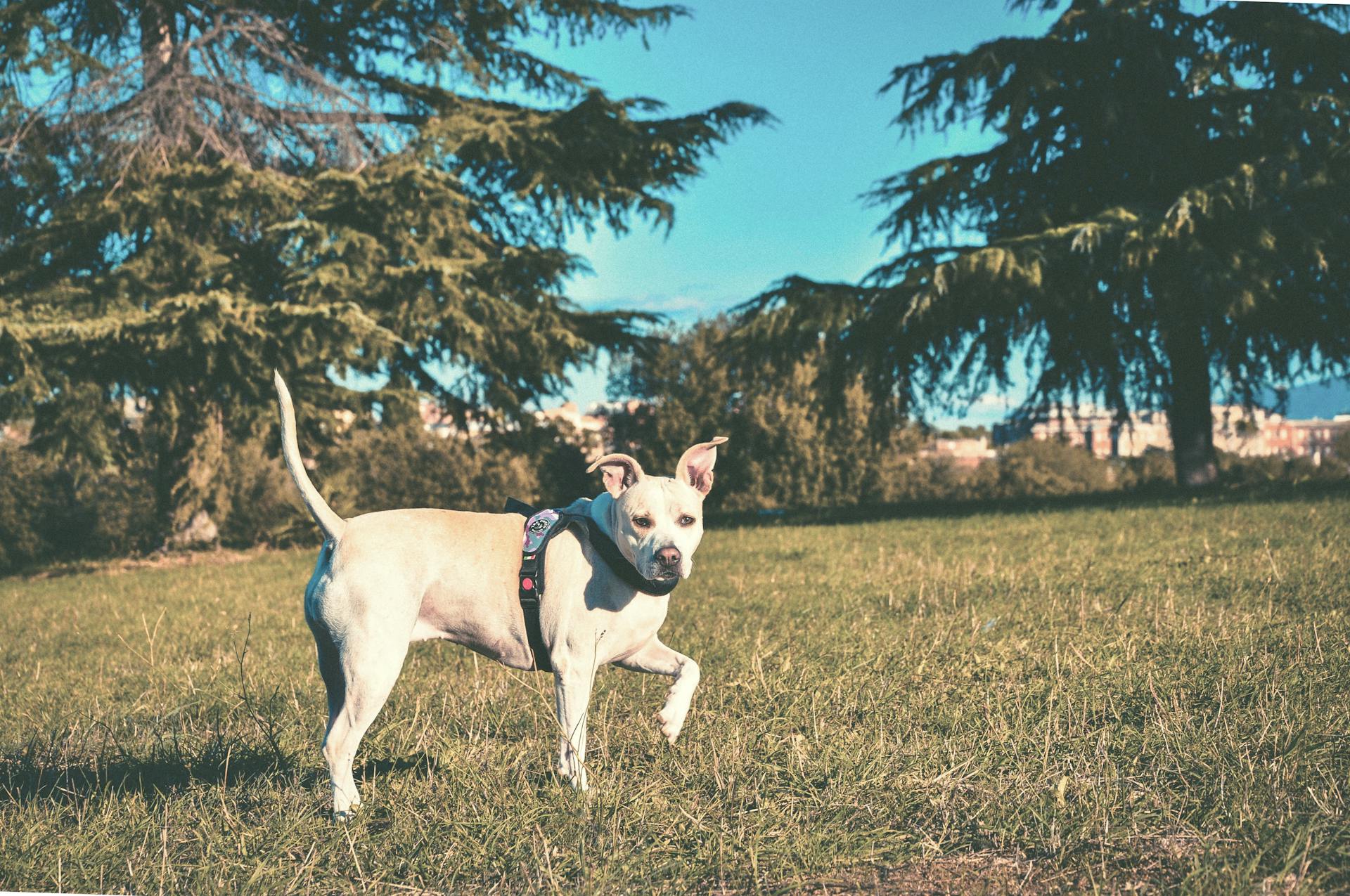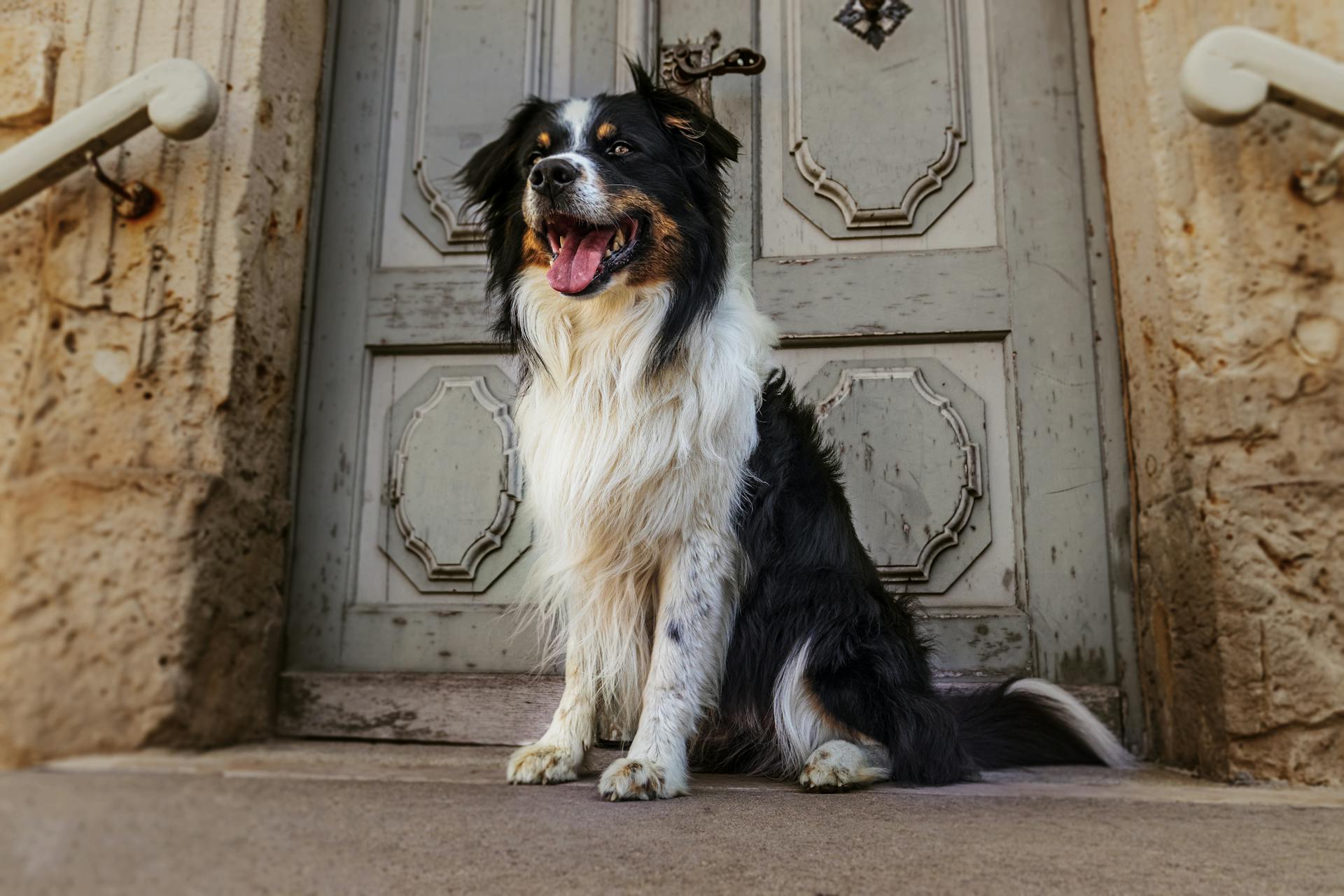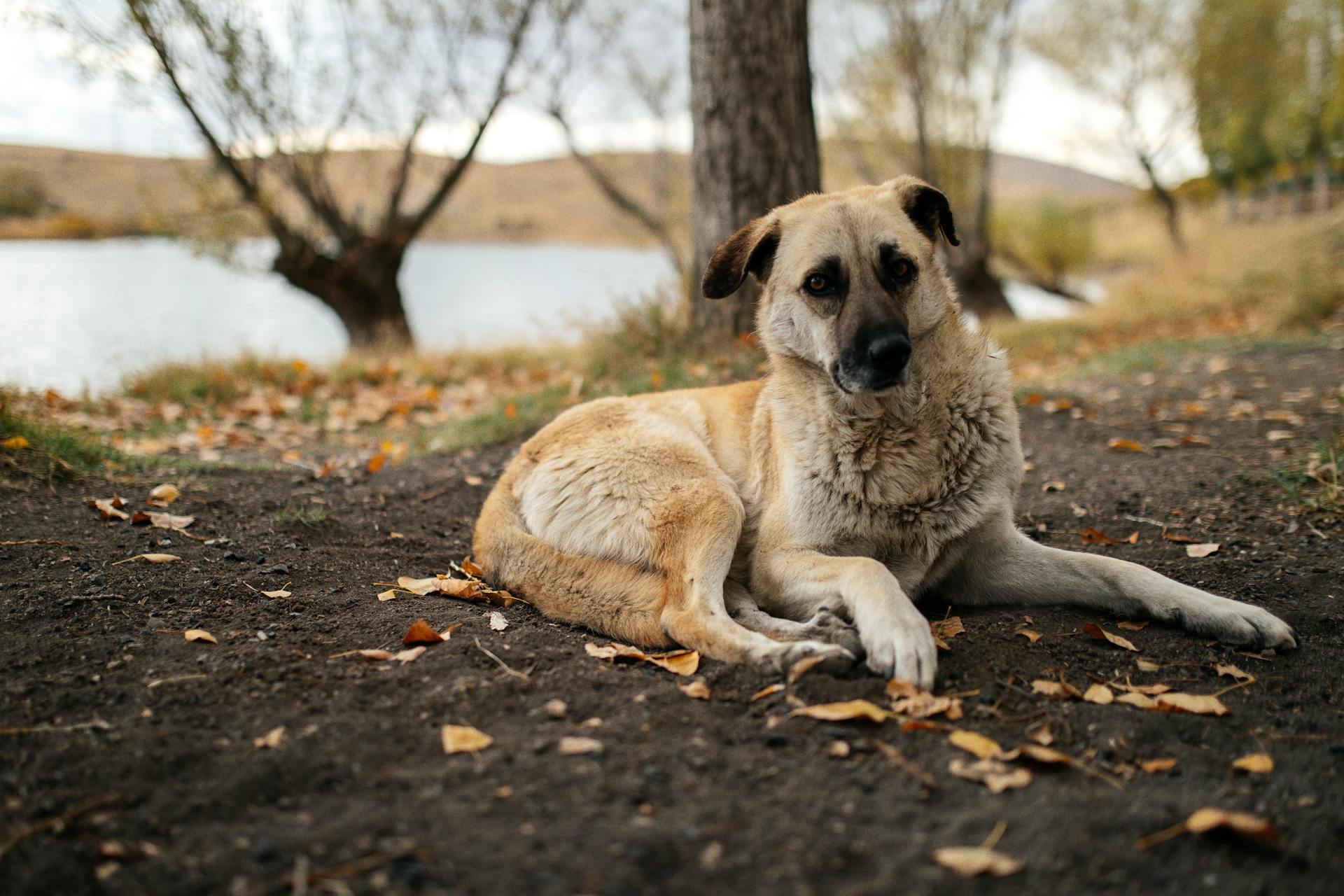
The Akbash Livestock Guardian Dog is a breed that's been around for centuries, originating in Turkey. They were bred to protect sheep and other livestock from predators.
Akbash dogs are naturally protective of their flock, which includes animals of all sizes. They're not just guard dogs, but also loyal companions to the farmers who rely on them.
These dogs are known for their intelligence, loyalty, and strong instinct to defend their territory. They're often referred to as "guardians" rather than "guard dogs" because of their unique relationship with their flock.
Their size is a significant factor in their ability to protect livestock, with males weighing up to 145 pounds.
History and Origins
The Akbash livestock guardian dog has a rich and fascinating history that spans thousands of years. It's an ancient pure breed native to the plains and mountains of western Turkey.
The breed's origins are obscure, but it's known to possess a unique combination of Mastiff and gazehound characteristics. This makes it a formidable guardian of sheep and other livestock.
In Turkey, Akbash dogs have been owned and bred by villagers and shepherds for centuries to protect their flocks from wolves and other predators. They're a vital part of the country's agricultural heritage.
Recognition of the Akbash breed as a distinct breed resulted from fieldwork done by Americans David and Judy Nelson in the 1970s. They studied the dogs in Turkey and eventually imported over 40 Akbash dogs to the United States, where they became the foundation stock for the breed.
The Akbash breed was added to the list of recognised native breeds and types in Turkey in 2006, and its breed standard was published in the Resmi Gazete, the official government gazette. This marked an important milestone in the breed's recognition and development.
The United Kennel Club recognized the Akbash Dog on January 1, 1998, as part of its Guardian Dog Group.
Physical Characteristics
The Akbash Livestock Guardian Dog is a large and powerful breed, with a mean body weight of approximately 45 kg (99 lb) and a mean height at the withers just over 75 cm (165 lb). This impressive size makes them a formidable guardian for sheep and other livestock.
Their coat is a double coat, consisting of longer, coarse, outer guard hairs and a dense undercoat made up of soft, fine hair. The thickness of the undercoat varies significantly with the climate and exposure of the dog to weather.
The Akbash Dog has a long-legged, lean, muscular build, with a wedge-shaped head and pendant ears. The ears are set rather high and lie flat to the skull, but when alert, they're carried slightly higher.
Intriguing read: Pembroke Welsh Corgi Floppy Ears
General Appearance
The Akbash Dog is a long-legged, lean, muscular dog of imposing size and strength, great courage, and stamina, with an alert, regal bearing.
The breed is slightly longer in proportion than tall, which gives it a unique appearance.
A wedge-shaped head with pendant ears is a distinctive feature of the Akbash Dog, with the ears being set rather high and lying flat to the skull.
The ears are pendant, V-shaped, and slightly rounded at the tips, and when alert, they are carried slightly higher.
You might like: Pembroke Welsh Corgi Ears
The tail is long and heavily feathered, usually carried in a curl over the back when the dog is moving or excited.
The Akbash Dog is slightly taller and heavier than the female, with the typical dog being proportionately taller and heavier than the bitch.
In both males and females, the breed is presented in a completely natural condition and should be evaluated equally for correct conformation, temperament, gait, and structural soundness.
The breed's natural appearance should not be penalized for honorable scars or other evidences of injury resulting from working in the field.
The Akbash Dog has two equally acceptable coat lengths: medium and long, with the long-coated dog having distinctly longer hair than the medium-coated dog.
Gait
The Akbash Dog's gait is truly unique and impressive. The feet travel close to the ground, giving the dog a low-slung, agile appearance.
As the dog moves, the legs don't travel parallel to each other, but rather close together at the ground, creating a smooth and efficient stride. This is especially noticeable when viewed from the front or rear.
As the speed increases, the legs gradually angle more inward, almost single-tracking, which helps the dog to cover more ground with each step. The hind legs reach far under, meeting or even passing the imprints of the front legs, creating a beautiful, fluid motion.
Unless the dog is excited, the head is carried rather low at the level of the shoulders, giving the Akbash Dog a calm and dignified appearance. When alert, however, the dog moves with determination and purpose toward the object of interest.
Characteristics of the
The Akbash is a large and powerful dog, with a mean body weight of approximately 45 kg (99 lb) and a mean height at the withers just over 75 cm (165 lb).
Its coat is double-layered, with a medium or long length, and is usually white with some shading towards a biscuit color. There's considerable feathering behind the legs and the tail is heavily feathered.
The Akbash has a calm and steady temperament, making it a great companion for families with children and pets. However, it's also naturally watchful of other dogs and may react aggressively to intruding dogs on its own territory.
Here are some key characteristics of the Akbash breed:
Akbash Breed
The Akbash breed is a remarkable one, originating from Turkey and bred specifically to guard livestock from predators like wolves and bears.
These dogs can weigh up to 50 kilograms, making them a formidable presence on the farm or ranch.
Akbash dogs are independent and fearless, which can sometimes make them seem aloof to strangers.
To become a good companion and effective guardian, Akbash dogs require consistent training and socialisation from a young age.
They are loyal and affectionate with their families, but their strong-willed nature means they're not recommended for first-time dog owners.
With proper training and socialisation, however, the Akbash dog can become a reliable and devoted companion.
Consider reading: How to Become a Search and Rescue Dog Handler
Guardian Dog Traits
I've kept an Akbash livestock guardian dog as a goat guard, and I can attest to their remarkable traits. One of the most impressive characteristics of Akbash dogs is their low "prey drive", meaning they have virtually no instinct to hunt, stalk, or kill small animals.
They're incredibly protective of their herd and bond strongly with the animals, living with them and defending them from predators. This independence is a hallmark of livestock guardian breeds, allowing them to make their own decisions regarding their herd and threats.
Akbash dogs are large and powerful, able to fight against wolves, large cats, and even bears. Their double coat of hair provides excellent insulation against extreme weather, both hot and cold.
On a similar theme: Indestructible Dog Toy for Large Dogs
Guardian Dogs
I keep a livestock guardian dog, and I can attest to their unique traits. They're incredibly protective of their herd, bonding with the animals and living with them to defend against predators.
Their low "prey drive" is a game-changer, as it means they won't chase after small animals or wildlife. This makes them perfect for guarding goats and other livestock.
One of the things I love most about my goat guard dog is their independence - they don't need much human instruction and often make their own decisions regarding their herd.
Their large size is also a huge plus, as they're capable of fighting against wolves, large cats, and even bears. It's a comforting feeling knowing they're watching over the animals.
Their double coat of hair provides excellent insulation against extreme weather, keeping them warm in the cold and cool in the heat. It's a testament to their adaptability and hardiness.
Related reading: Big Mountain Dogs
Training
Training your akbash requires patience and consistency, as its independent and stubborn nature can make it challenging to train, even though it's quite smart and can understand commands.
Start training your akbash as a puppy using positive-reinforcement methods like treats and praise. This approach will help instill good behaviors and prevent bad habits from forming.
Consistency is key when training your akbash, so make sure to set clear expectations and reward good behavior. It's also essential to be consistent in the behavior you expect when giving a command.
Give your akbash plenty of positive experiences around new people and other dogs from an early age to help curb its protective and territorial nature. This can be done by exposing it to various locations and social situations.
Exercising caution is necessary when introducing your akbash to strangers and other dogs, as its protective instinct can be difficult to fully quell.
For another approach, see: Pembroke Welsh Corgi Temperament Protective
Care and Maintenance
Akbash livestock guardian dogs are relatively low-maintenance pets when it comes to exercise, but they do require regular grooming.
You'll need to brush your akbash at least weekly to remove loose fur and prevent tangles and mats.
Their coats can get quite tangled, especially in areas with feathering, so be sure to pay extra attention to those areas.
Expect periods of higher shedding twice a year in the spring and fall, which may require daily brushing to keep up with the loose fur.
Bathe your akbash about once a month, depending on how dirty it gets.
Don't forget to check your dog's ears weekly for dirt, wax buildup, and other abnormalities.
Aiming to brush its teeth daily is also a good idea to keep your akbash's oral health in check.
Checking your dog's nails monthly can help you determine whether they need a trim.
Health and Nutrition
Akbash livestock guardian dogs are a breed of dog specifically designed to protect sheep and other livestock from predators. They are a natural and effective way to safeguard your flock.
Their robust build and strong instincts make them well-suited for this task, allowing them to keep predators at bay without posing a threat to the animals they're guarding.
Akbash dogs are also known for their intelligence and loyalty, traits that make them ideal companions for farmers and shepherds.
Teeth
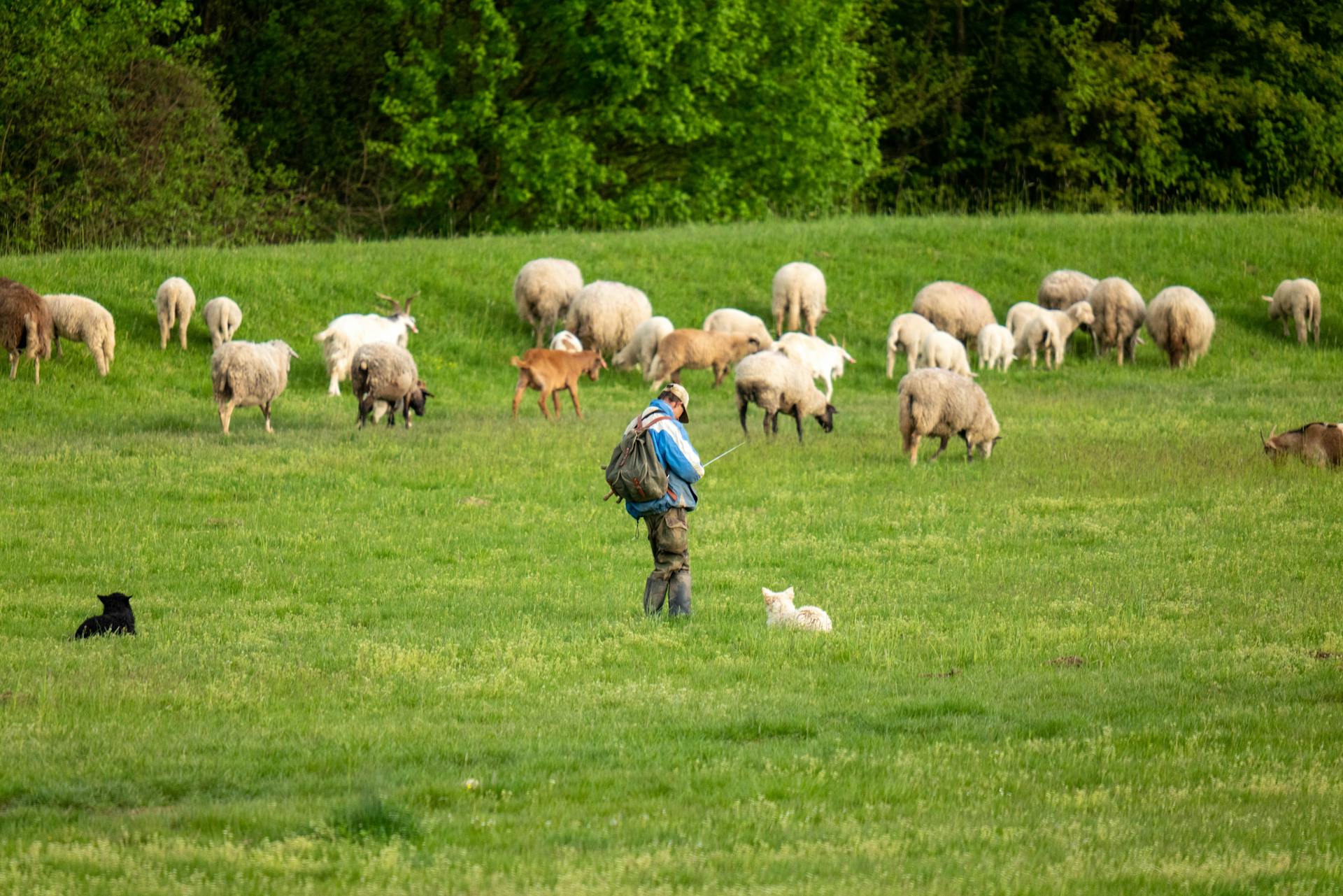
The Akbash Dog's teeth are a vital part of their overall health and nutrition. They have a complete set of large, evenly spaced, white teeth.
A scissors bite is actually preferred for the Akbash Dog, but a level bite is also acceptable. Broken teeth resulting from field work are not something to worry about, as they are not considered a fault.
Serious dental issues to watch out for include an over or undershot bite, and if your Akbash Dog is missing more than two teeth.
For more insights, see: Dog Food for Dogs with No Teeth
Common Health Problems
The Akbash is generally a healthy dog, but like all breeds, it can be prone to certain health issues. Hip dysplasia is a common problem that can affect the Akbash, leading to arthritis and mobility issues.
Hip dysplasia can be a painful condition, and it's essential to monitor your Akbash's joint health from an early age. Some owners have reported that regular exercise and a balanced diet can help prevent or manage hip dysplasia.
Here's an interesting read: Pembroke Welsh Corgi Health Problems
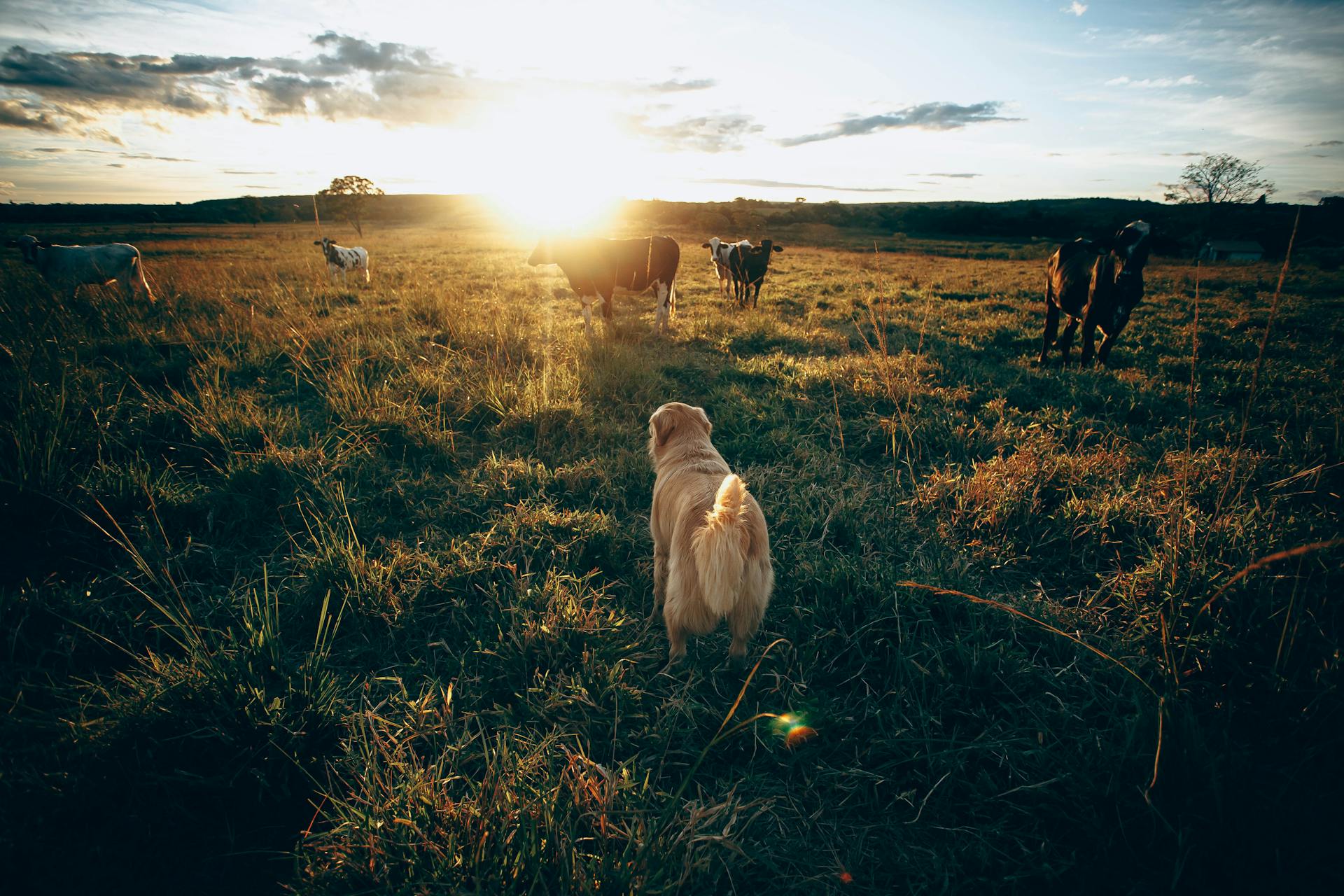
Cruciate ligament injuries are another potential health issue that can affect the Akbash. These injuries can occur due to sudden movements or trauma, and they can be painful and debilitating.
Hypothyroidism is a common endocrine disorder that can affect the Akbash. It's characterized by a decrease in thyroid hormone production, which can lead to weight gain, skin problems, and other symptoms.
Dilated cardiomyopathy is a heart condition that can affect the Akbash, causing the heart to become enlarged and less efficient. This can lead to symptoms such as coughing, fatigue, and shortness of breath.
Gastric dilatation volvulus, also known as bloat, is a life-threatening condition that can affect the Akbash. It occurs when the stomach twists and fills with gas, cutting off blood flow and leading to rapid deterioration.
Cancer and kidney disease are also potential health risks for the Akbash. These conditions can be caused by a combination of genetic and environmental factors, and they can be managed with proper care and treatment.
To minimize the risk of these health issues, it's essential to work with a reputable breeder who prioritizes health testing and responsible breeding practices. Regular veterinary check-ups and a balanced diet can also help keep your Akbash healthy and thriving.
Here are some common health problems that can affect the Akbash:
- Hip dysplasia
- Cruciate ligament injuries
- Hypothyroidism
- Dilated cardiomyopathy
- Gastric dilatation volvulus (bloat)
- Cancer
- Kidney disease
- Epilepsy
Diet and Nutrition
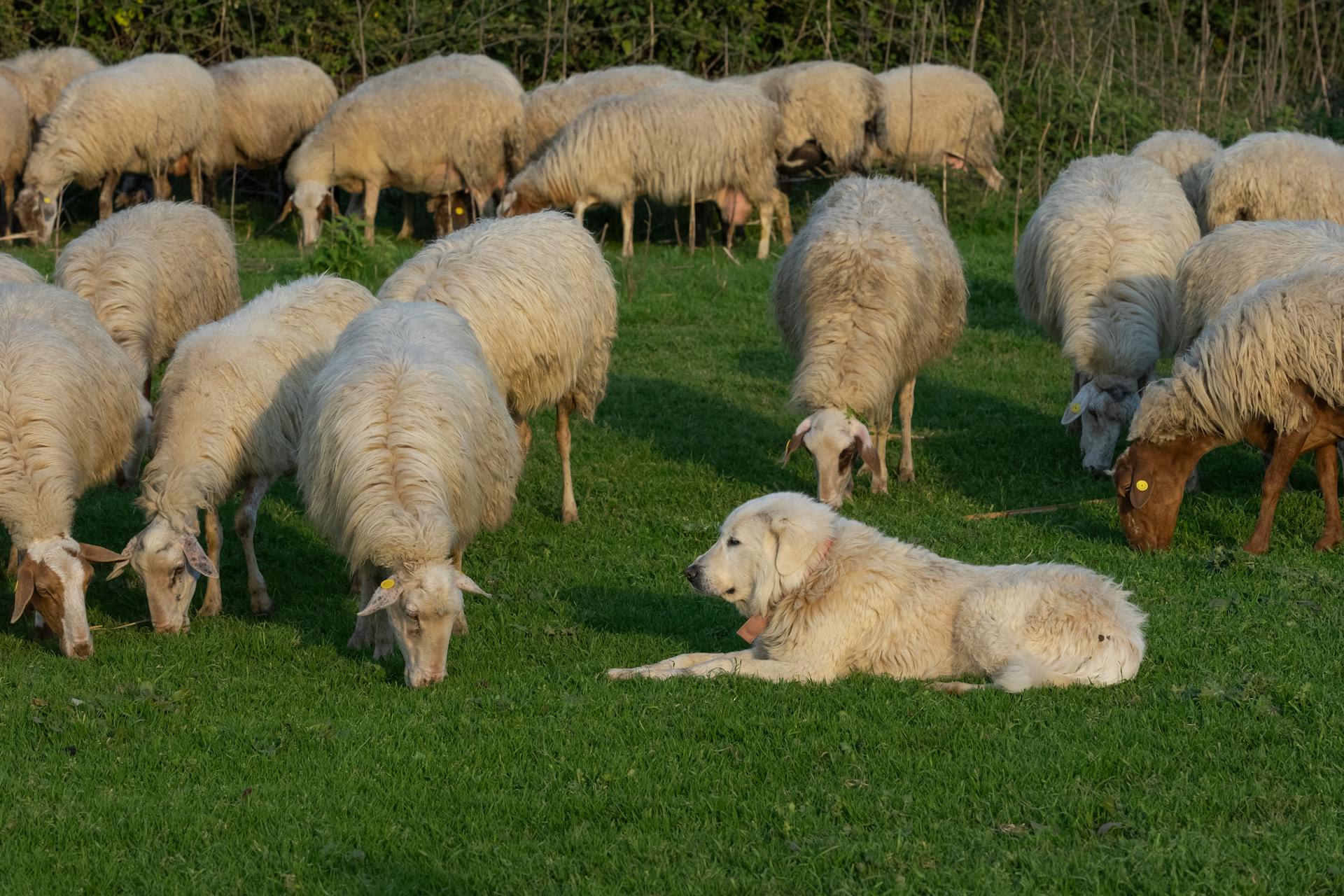
When feeding your akbash, make sure to provide fresh water at all times, and consider using a large water bowl due to their big size.
A quality, nutritionally balanced canine diet is essential for your akbash's well-being. You may want to discuss with your vet the type of diet that's best for your dog.
Feeding two measured meals per day is typical, but this breed is prone to bloat and stomach twisting, which can be life-threatening.
Feeding smaller, more frequent meals can help prevent bloat and stomach twisting, especially if your dog tends to eat too quickly. Keeping your dog calm during mealtimes can also make a big difference.
A food formulated especially for large breeds might be beneficial for your akbash's diet.
A unique perspective: Bernese Mountain Dog Feeding Chart
Comparing Livestock Breeds
The Akbash is a large, powerful dog with a muscular build, weighing between 80-120 pounds and standing 25-31 inches tall.
Its size and strength make it an effective guardian against predators, such as coyotes and wolves.
The Akbash's thick coat is also well-suited for the harsh climates of the Middle East and Central Asia, where the breed originated.
In comparison, the Maremma sheepdog is a smaller breed, weighing 70-100 pounds and standing 23-27 inches tall.
Maremmas are highly social dogs that thrive in the company of humans and other animals, making them a popular choice for farmers and ranchers.
The Great Pyrenees, another popular livestock guardian breed, is known for its gentle nature and calm demeanor, making it an excellent choice for families with children.
Despite its size, the Great Pyrenees is relatively low-maintenance, requiring less exercise and training than some other breeds.
The Kangal Dog, a Turkish breed, is similar in size to the Akbash and is also known for its protective instincts and strong herding ability.
Kangals are highly intelligent and trainable, making them a popular choice for farmers and herders.
In contrast, the Komondor is a Hungarian breed known for its distinctive corded coat and strong protective instincts.
Komondors are highly loyal and alert dogs that make excellent guardians for livestock and property.
Worth a look: Bernese Mountain Dog Coat
Their intelligence and trainability also make them a popular choice for families and herders.
The Peruvian Inca Orchid is a smaller breed, weighing 35-55 pounds and standing 17-19 inches tall.
Despite its size, the Peruvian Inca Orchid is a highly effective guardian against predators, thanks to its strong herding ability and protective instincts.
These breeds, including the Akbash, are well-suited for guarding livestock in various climates and environments.
Expand your knowledge: Peruvian Hairless Dog
Frequently Asked Questions
What are the pros and cons of Akbash dogs?
Akbash dogs are intelligent and protective companions, but their strong will and potential aggression may make them challenging to train and own for inexperienced handlers. With proper training and socialization, they can be loyal and loving pets for active families.
Are Akbash dogs aggressive?
Akbash dogs are not inherently aggressive, but they can be protective and suspicious of strangers, making proper training and socialization crucial.
What is the most aggressive livestock guardian dog?
The Akbash breed is considered the most aggressive and protective livestock guardian dog, making it a top choice for safeguarding small ruminants from predators. Its strong instincts and guarding abilities make it an effective guardian for larger range flocks.
Sources
- https://en.wikipedia.org/wiki/Akbash
- https://petcontrolhq.com/en-us/blogs/news/best-livestock-guardian-dog-breeds
- https://backyardgoats.iamcountryside.com/ownership/livestock-guardian-dog-breed-comparison/
- https://www.ukcdogs.com/akbash
- https://www.thesprucepets.com/akbash-full-profile-history-and-care-5079006
Featured Images: pexels.com
